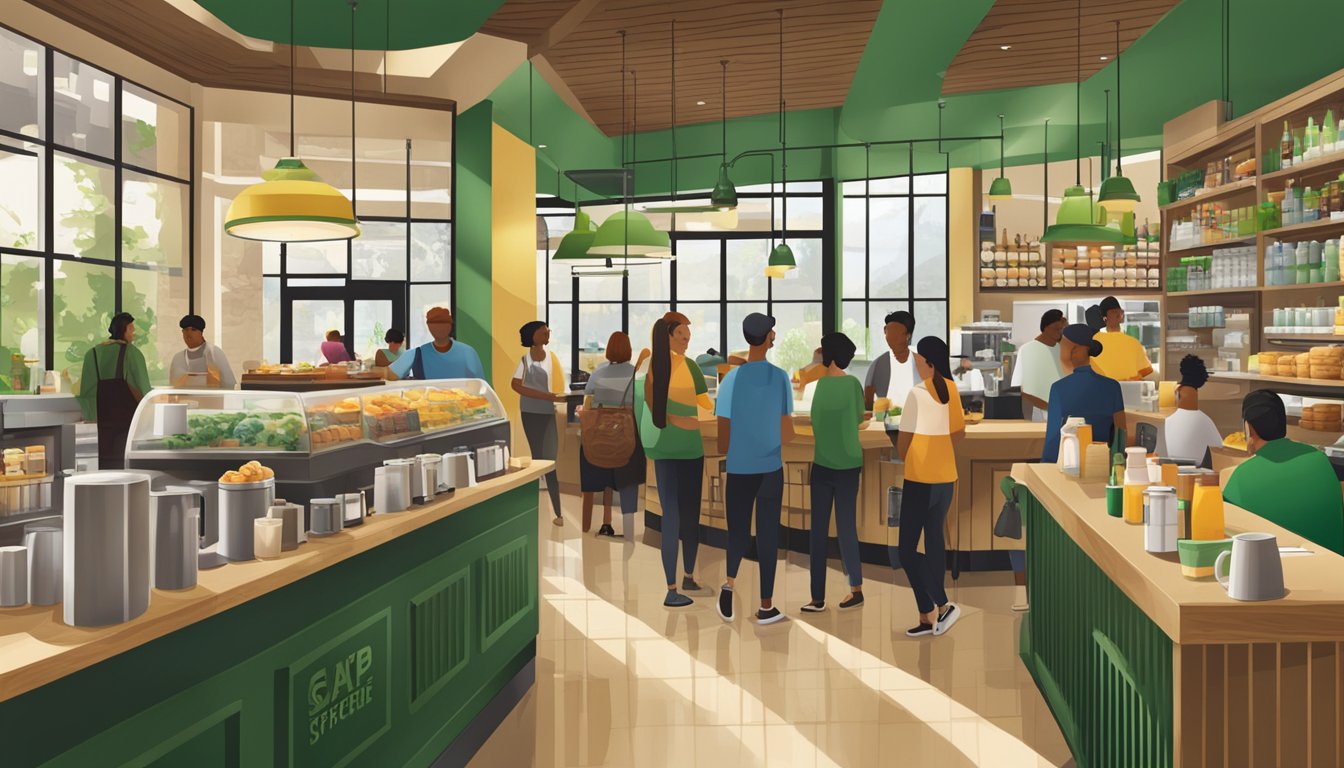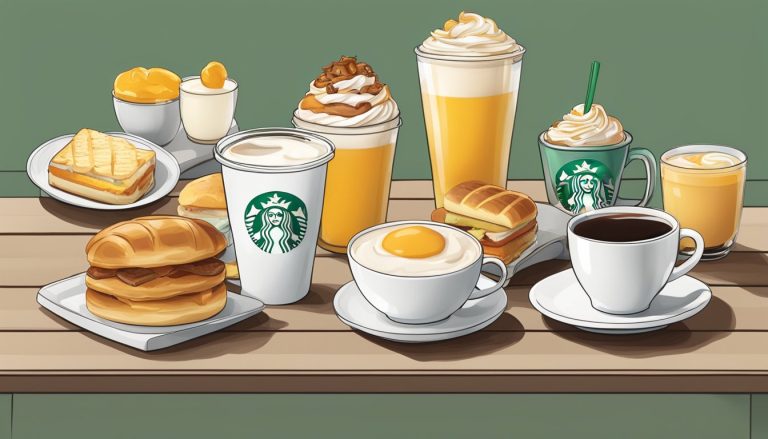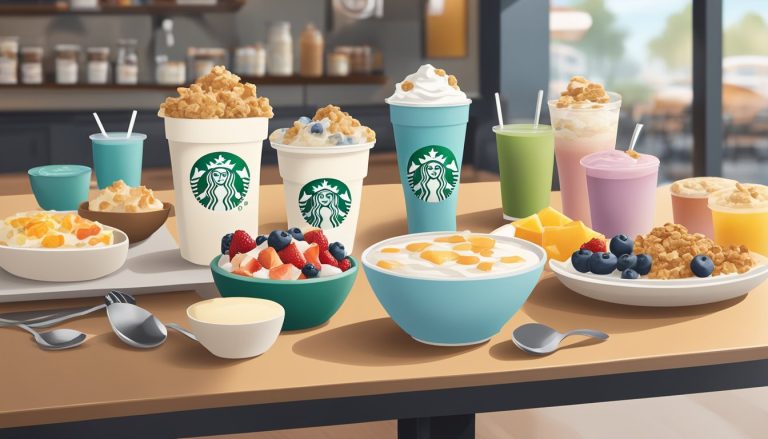Starbucks revolutionized the way people think about and consume coffee. Since its humble beginnings in 1971 as a small coffee bean store in Seattle, the company has grown into a global phenomenon that has redefined coffee culture worldwide. Starbucks transformed coffee from a simple beverage into a cultural experience, introducing the concept of the “third place” – a social environment distinct from home and work.
The rise of Starbucks coincided with a shift in consumer preferences towards premium coffee and a desire for a more sophisticated coffee-drinking experience. As the company expanded, it introduced a wide range of breakfast options to complement its coffee offerings, further solidifying its place in people’s daily routines. This move not only increased Starbucks’ revenue but also contributed to the growing trend of breakfast consumption in coffee shops.
Starbucks’ success has inspired countless imitators and competitors, leading to a proliferation of coffee shops around the world. This expansion has had a significant impact on urban landscapes, social interactions, and work habits. Coffee shops have become places for meetings, remote work, and social gatherings, reflecting the changing nature of modern life and the central role that coffee culture now plays in many societies.
The Historical Roots of Starbucks

Starbucks’ journey from a single storefront to a global coffee powerhouse began in Seattle. The city’s coffee culture and a historic market played pivotal roles in shaping the brand’s identity and early growth.
Seattle’s Coffee Origins
Seattle’s rainy climate and maritime culture created an ideal environment for coffee appreciation. The city’s residents sought warm, caffeinated beverages to combat the damp chill. Local roasters and importers flourished, supplying beans to a growing number of coffeehouses.
This coffee-centric atmosphere laid the groundwork for Starbucks’ inception. The city’s appreciation for quality brews and cozy gathering spaces aligned perfectly with the founders’ vision.
Pike Place Market and Starbucks’ Birth
In 1971, three partners – Jerry Baldwin, Zev Siegl, and Gordon Bowker – opened the first Starbucks store in Seattle’s Pike Place Market. This historic location remains an iconic tourist destination today.
Initially, Starbucks focused solely on selling roasted coffee beans and equipment. The founders were inspired by Alfred Peet, a coffee roasting pioneer. They sourced high-quality arabica beans and emphasized dark roasts, distinguishing themselves from typical American coffee.
The Growth of a Coffee Shop Icon
Howard Schultz joined Starbucks as director of marketing in 1982. His 1983 trip to Milan proved transformative, inspiring him to recreate the Italian coffeehouse experience in America.
Schultz’s vision met resistance from the original founders. He left to start Il Giornale, a coffee bar chain, in 1985. Two years later, Schultz acquired Starbucks and merged the companies.
Under Schultz’s leadership, Starbucks rapidly expanded. By 1992, the company went public with 140 stores. Starbucks’ green siren logo became synonymous with premium coffee and a “third place” between work and home.
Starbucks’ Influence on Coffee Culture
Starbucks revolutionized how people consume and perceive coffee, transforming it from a simple beverage into a cultural phenomenon. The company introduced new concepts, borrowed from Italian traditions, and crafted a unique experience that reshaped coffee culture globally.
The Concept of the ‘Third Place’
Starbucks popularized the idea of the “third place” – a social space separate from home and work. This concept, rooted in sociological theory, positioned Starbucks as a community gathering spot. Stores were designed with comfortable seating, ambient lighting, and inviting decor to encourage lingering and socializing.
The company trained baristas to remember customer names and preferences, fostering a sense of belonging. This personalized approach helped build customer loyalty and created a unique atmosphere that set Starbucks apart from traditional diners and cafes.
Starbucks’ success with the “third place” concept influenced other businesses, leading to a proliferation of coffee shops and cafes designed as social hubs.
Italian Coffeehouse Influence
Starbucks drew inspiration from Italian coffee culture, adapting it for the American market. The company introduced espresso-based drinks like lattes and cappuccinos, previously unfamiliar to many U.S. consumers.
Starbucks adopted Italian coffeehouse terminology, familiarizing customers with words like “barista,” “grande,” and “venti.” This language became part of the Starbucks experience and eventually entered common usage.
The company also emulated the Italian tradition of coffee as a social ritual, encouraging customers to savor their drinks and enjoy conversations. This approach contrasted with the prevalent grab-and-go coffee culture in the United States.
Creating the Starbucks Experience
Starbucks crafted a distinctive coffeehouse experience that became its hallmark. The company focused on creating a multisensory environment, from the aroma of freshly ground beans to the sound of espresso machines.
Store designs incorporated elements like warm colors, natural materials, and local artwork to create a welcoming atmosphere. Starbucks also introduced seasonal drinks and merchandise, turning coffee consumption into a lifestyle choice.
The company’s emphasis on customization allowed customers to personalize their drinks, fostering a sense of individuality. This approach influenced other coffee shops and restaurants to offer more personalized options.
Starbucks’ mobile app and rewards program further enhanced the customer experience, integrating technology with coffee consumption. These innovations set new standards for convenience and customer engagement in the coffee industry.
Innovation at Starbucks
Starbucks has consistently pushed boundaries in product development, technology adoption, and creative marketing. These innovations have helped solidify its position as a global coffee leader.
Product Innovations
Starbucks revolutionized the coffee industry with the introduction of the Frappuccino in 1995. This blended ice beverage became an instant hit, attracting new customers and boosting sales. The company has since expanded its menu with seasonal offerings like the Pumpkin Spice Latte, launched in 2003. This autumnal drink sparked a flavor trend across the food and beverage industry.
Starbucks also pioneered customization options, allowing customers to personalize their drinks. This approach catered to individual preferences and dietary needs, enhancing customer satisfaction.
Technological Advances
The Starbucks mobile app, introduced in 2009, transformed the customer experience. It enabled mobile ordering and payments, reducing wait times and increasing convenience. The app also integrated the company’s rewards program, driving customer loyalty and repeat visits.
Starbucks has invested in artificial intelligence to optimize store operations and personalize marketing. The company uses data analytics to predict customer preferences and tailor promotions.
Marketing Strategies
Starbucks’ marketing innovations have focused on creating emotional connections with customers. The company’s holiday cup designs, introduced in 1997, became an annual tradition and marketing phenomenon.
Social media campaigns have played a crucial role in Starbucks’ marketing strategy. The company leverages platforms like Instagram to showcase new products and engage with customers.
Starbucks has also embraced cause marketing, supporting various social and environmental initiatives. This approach has resonated with socially conscious consumers and enhanced brand perception.
Starbucks’ Commitment to Sustainability
Starbucks has made significant strides in sustainability, focusing on responsible sourcing and environmental stewardship. The company aims to give more than it takes from the planet through various initiatives and partnerships.
Ethical Sourcing of Coffee Beans
Starbucks prioritizes ethical sourcing of coffee beans to support farmers and communities. The company works directly with coffee growers to ensure fair wages and sustainable farming practices. Starbucks’ C.A.F.E. (Coffee and Farmer Equity) Practices program sets standards for quality, economic accountability, social responsibility, and environmental leadership.
Through this program, Starbucks has:
- Purchased 99% of its coffee through ethical sourcing practices
- Invested over $100 million in supporting coffee communities
- Provided loans to farmers for sustainable agriculture
The company also supports conservation efforts in coffee-growing regions to protect biodiversity and maintain healthy ecosystems.
Environmental Initiatives and Corporate Responsibility
Starbucks has implemented various environmental initiatives to reduce its ecological footprint. The company has set ambitious goals to cut carbon emissions, water usage, and waste.
Key environmental initiatives include:
- Developing more sustainable cold cups with up to 20% less plastic
- Introducing reusable cup programs to reduce single-use waste
- Achieving 30% recycled content in holiday cups
Starbucks aims to:
- Reduce carbon emissions by 50% by 2030
- Conserve or replenish 50% of water used in operations and coffee production
- Design and build 10,000 “Greener Stores” globally by 2025
These efforts demonstrate Starbucks’ commitment to corporate social responsibility and environmental sustainability across its global operations.
The Global Expansion of Starbucks
Starbucks transformed from a local Seattle coffee shop into an international powerhouse, expanding its reach across continents. The company’s growth strategy focused on entering new markets while maintaining a consistent brand identity.
The Growth of International Markets
Starbucks began its global expansion in the 1990s, starting with Canada in 1996. The company carefully selected markets with coffee-drinking cultures and growing middle classes. By 2025, Starbucks operates over 32,000 stores in more than 80 countries.
Key expansion milestones include:
- 1998: First European store opens in London
- 2000: Enters Asia with stores in Japan and Taiwan
- 2002: Mexico becomes first Latin American market
Starbucks adapts its offerings to local tastes while maintaining core products. In China, for example, the company introduced tea-based beverages and moon cakes to appeal to local preferences.
Branding and Global Presence
The iconic green mermaid logo serves as a universal symbol for Starbucks, recognized worldwide. This consistent branding helps create a familiar experience for customers across different countries.
Starbucks’ global presence extends beyond physical stores:
- Partnerships with local businesses and franchisees
- Airport and hotel locations
- Grocery store products
The company’s expansion strategy includes:
- Careful market research
- Adapting store designs to local architecture
- Training local staff in Starbucks’ customer service standards
Starbucks’ success in global markets stems from its ability to balance a strong brand identity with cultural sensitivity.
Fostering Community Connection
Starbucks has transformed coffee shops into vibrant social hubs, cultivating a sense of belonging and connection among customers. The company’s approach blends local engagement initiatives with the social nature of coffee consumption.
Building Local Community Engagement
Starbucks actively participates in local community development through various programs. Store managers often collaborate with neighborhood organizations to host events and support local causes. The company encourages employees to volunteer, creating a ripple effect of positive community impact.
Starbucks has implemented “Community Stores” in underserved areas. These locations partner with local nonprofits to provide job training and other services. The program aims to create economic opportunities and strengthen community ties.
Many Starbucks locations feature artwork from local artists, showcasing regional talent. This practice not only supports creatives but also helps each store reflect its neighborhood’s unique character.
Coffee as a Social Conductor
Coffee shops have become modern-day meeting places, fostering face-to-face interactions in an increasingly digital world. Starbucks designs its spaces to encourage conversation and connection among patrons.
Comfortable seating arrangements, including communal tables, promote social interaction. These layouts make it easy for strangers to strike up conversations or for friends to gather.
Starbucks’ “Third Place” concept positions its cafes as spaces between work and home where people can relax and socialize. This philosophy has contributed to the coffeehouse becoming a cultural phenomenon.
The ritual of sharing coffee has become a social lubricant, facilitating business meetings, study groups, and casual catch-ups. Starbucks’ diverse menu caters to various preferences, ensuring there’s something for everyone in the group.
The Future of Starbucks and Coffee Shops
Starbucks is pioneering new strategies to shape the future of coffee shops and meet evolving consumer demands. The company is focusing on digital expansion, sustainability, and global growth while adapting its in-store experience.
Advancing the Coffee Industry
Starbucks aims to lead coffee industry innovation through its “Bridge to the Future” strategy. The company is investing in new brewing technologies like Clover Vertica machines to serve drip coffee more efficiently by 2025. This will allow Starbucks to speed up order processing and improve customer service.
Sustainability is a key focus area. Starbucks is working to reduce its environmental impact through initiatives like recyclable packaging and energy-efficient store designs. The company is also partnering with coffee farmers to promote sustainable growing practices.
Global expansion remains a priority. With over 20,000 stores outside the U.S., Starbucks continues to enter new markets and grow its international presence. The partnership with Nestlé has helped Starbucks become the market share leader in U.S. at-home coffee.
Adapting to New Consumer Behaviors
Digital innovation is reshaping the Starbucks experience. The company is enhancing its mobile app and rewards program to offer personalized promotions and convenient ordering options. Drive-thru and pickup-only store formats are being expanded to cater to on-the-go customers.
Starbucks is also focusing on specialty coffee offerings to appeal to discerning consumers. The company is introducing new drink customization options and expanding its selection of single-origin and small-batch coffees.
To address changing work patterns, Starbucks is redesigning stores to accommodate remote workers and create community spaces. Enhanced WiFi, more power outlets, and comfortable seating areas are being added to encourage longer visits and foster social connections.




